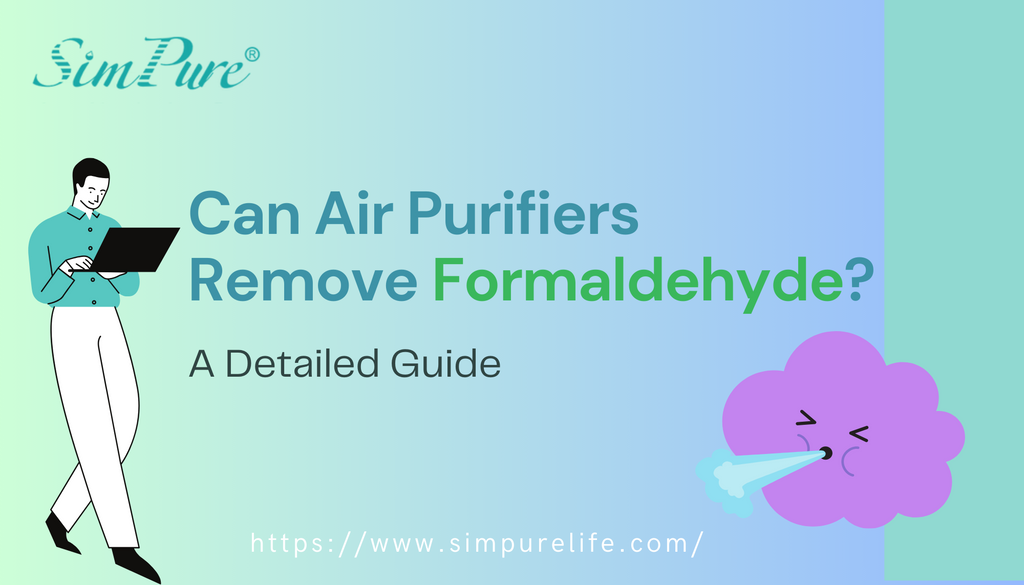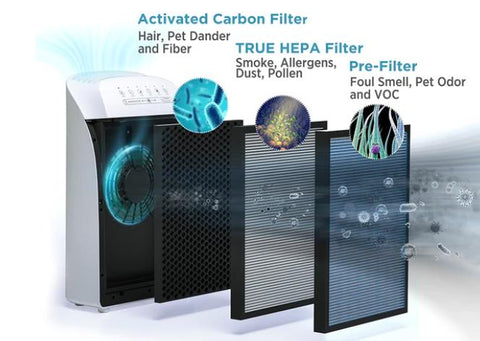Yes, air purifiers can help remove formaldehyde from indoor air. They use specific filters and technologies to target this harmful chemical.
Formaldehyde is a common pollutant found in many homes. It comes from building materials, furniture, and household products. Exposure to formaldehyde can cause health issues like headaches, respiratory problems, and even cancer. Therefore, it is crucial to maintain indoor air quality.
Air purifiers equipped with activated carbon filters or other advanced technologies can reduce formaldehyde levels. These devices work by trapping and breaking down the chemical, making the air safer to breathe. Understanding how air purifiers tackle formaldehyde can help you make informed decisions about improving your home’s air quality.
Introduction To Formaldehyde
Formaldehyde is a common chemical found in many indoor environments. It is a colorless gas with a strong smell. Often used in building materials and household products, it is hard to avoid. Understanding formaldehyde and its sources can help you reduce exposure.
Sources Of Formaldehyde
Many items in homes release formaldehyde. Pressed wood products like plywood and particleboard are major sources. These materials often have urea-formaldehyde resins. Also, household items like furniture, carpets, and fabrics can emit formaldehyde. Smoking indoors and using unvented gas stoves also release this gas. Even some cosmetics and personal care products contain it.
Health Risks Of Formaldehyde
Formaldehyde exposure can cause many health problems. Short-term exposure can irritate the eyes, nose, and throat. It may lead to coughing, wheezing, and skin rashes. Long-term exposure is more serious. It can cause chronic respiratory issues. Formaldehyde is also a known carcinogen. This means it can increase cancer risk. Reducing formaldehyde levels indoors is important for health.

Credit: www.simpurelife.com
How Air Purifiers Work
Understanding how air purifiers work can help you decide if they can remove formaldehyde from your indoor air. These devices are designed to clean the air by trapping or destroying pollutants. Let’s explore the basic mechanism and the different types of air purifiers available.
Basic Mechanism
Air purifiers operate by pulling in air through a series of filters. The air passes through these filters, which trap various pollutants. The clean air is then released back into the room. This cycle continues, ensuring continuous purification of indoor air.
Most air purifiers use a fan to draw in air. They also use filters to capture particles. Some models use additional technologies like UV light or ionization.
Types Of Air Purifiers
There are several types of air purifiers, each with its unique way of cleaning the air:
- HEPA Filters: These are highly effective at trapping particles as small as 0.3 microns. They are great for allergens and dust.
- Activated Carbon Filters: These filters excel at absorbing gases and odors. They can trap formaldehyde and other VOCs (volatile organic compounds).
- UV-C Light Purifiers: These use ultraviolet light to kill bacteria and viruses. They are less effective against formaldehyde.
- Ionizers: These release charged ions into the air. The ions attach to particles, making them heavier and causing them to fall out of the air. They are less effective for gas pollutants.
- Ozone Generators: These produce ozone to neutralize pollutants. They are controversial due to the potential health risks associated with ozone exposure.
Choosing the right air purifier depends on your specific needs. For formaldehyde, activated carbon filters are the most effective.
Hepa Filters And Formaldehyde
HEPA filters are well-known for their efficiency in trapping airborne particles. But can they remove formaldehyde from indoor air? Formaldehyde is a common indoor pollutant. Understanding the function and limitations of HEPA filters can help you decide if they are right for your needs.
Function Of Hepa Filters
HEPA filters are designed to capture particles as small as 0.3 microns. They are effective at trapping dust, pollen, and pet dander. These filters work by forcing air through a fine mesh. This mesh traps harmful particles. HEPA filters are excellent for improving air quality.
They do this by removing many common allergens. This can make a big difference for allergy sufferers.
Limitations Of Hepa Filters
Despite their many benefits, HEPA filters have limitations. They are not designed to remove gases or odors. Formaldehyde is a gas. This means HEPA filters alone cannot remove formaldehyde. To tackle formaldehyde, you need additional technology.
Activated carbon filters can help. These filters absorb gases and odors. Combining HEPA and activated carbon filters offers better protection. This dual approach can improve overall indoor air quality.
Activated Carbon Filters
Activated carbon filters are popular for removing pollutants from indoor air. These filters are especially effective at capturing gases and volatile organic compounds (VOCs). One of the most harmful VOCs is formaldehyde, a common indoor pollutant.
How Activated Carbon Works
Activated carbon filters contain small, porous granules of carbon. These granules have a large surface area, which allows them to trap pollutants. The carbon is treated with oxygen to open up millions of tiny pores. These pores catch gases and chemicals as air passes through the filter.
The process is called adsorption. In adsorption, pollutants stick to the surface of the carbon granules. This is different from absorption, where pollutants would be soaked into the material. Because of adsorption, activated carbon filters can remove a wide range of chemicals from the air.
Effectiveness Against Formaldehyde
Formaldehyde is a common indoor air pollutant. It comes from building materials, furniture, and household products. Long-term exposure can lead to serious health problems. Activated carbon filters can effectively reduce formaldehyde levels.
Studies show that activated carbon filters can remove up to 90% of formaldehyde. The effectiveness depends on the amount of carbon in the filter and the airflow rate. It is important to choose a high-quality filter with enough carbon.
To further improve the removal of formaldehyde, some filters include additional treatments. These treatments enhance the carbon’s ability to capture formaldehyde molecules.
In summary, activated carbon filters are a reliable choice for reducing formaldehyde in indoor air. They work through adsorption, trapping harmful gases on their surface. Investing in a good-quality filter can help create a healthier home environment.
Peco Technology
PECO Technology (Photo Electrochemical Oxidation) represents a significant advancement in air purification. It is highly effective at removing harmful chemicals like formaldehyde from indoor air. Let’s dive into how this technology works and its advantages over traditional filters.
Mechanism Of Peco
PECO technology uses a light-activated catalyst to break down pollutants at a molecular level. This includes volatile organic compounds (VOCs) such as formaldehyde. The process involves:
- Air passes through a filter coated with a special catalyst.
- UV light activates this catalyst.
- Activated catalyst breaks down pollutants into harmless molecules.
Unlike traditional filters, PECO doesn’t just trap pollutants. It destroys them. This ensures cleaner and safer indoor air.
Advantages Over Other Filters
PECO technology offers several advantages:
- Effective Formaldehyde Removal: Traditional HEPA filters can’t remove gases like formaldehyde. PECO technology can.
- Destroys Pollutants: PECO doesn’t just trap pollutants. It destroys them, ensuring they don’t re-enter the air.
- Broad Spectrum: PECO can handle a wide range of pollutants, including VOCs, bacteria, and viruses.
PECO technology ensures your indoor air is not just clean but also free from harmful chemicals. It’s a reliable choice for improving air quality.

Credit: www.ebay.com
Choosing The Right Air Purifier
Formaldehyde is a harmful chemical found in many indoor environments. It can cause various health problems. To combat this, many people turn to air purifiers. But not all air purifiers can remove formaldehyde. So, how do you choose the right one? Let’s explore the key features and popular models to help you make an informed decision.
Key Features To Look For
When choosing an air purifier for formaldehyde removal, focus on these key features:
- HEPA Filters: High-Efficiency Particulate Air (HEPA) filters can trap small particles. Look for purifiers with True HEPA filters.
- Activated Carbon Filters: These filters are crucial for removing gases and odors. They can effectively absorb formaldehyde.
- CADR Rating: Clean Air Delivery Rate (CADR) measures the purifier’s efficiency. Choose a model with a high CADR rating for gases.
- Air Quality Sensors: These sensors monitor indoor air quality. They adjust the purifier’s settings automatically for optimal performance.
- Noise Level: A quiet air purifier is ideal for home use. Check the decibel rating to ensure it won’t disrupt your environment.
Popular Models In The Market
Here are some popular air purifier models known for their formaldehyde removal capabilities:
| Model | Key Features |
|---|---|
| Dyson Pure Cool TP04 |
|
| Levoit LV-PUR131 |
|
| Honeywell HPA300 |
|
These models offer a range of features to ensure cleaner, safer indoor air. Choose one that fits your specific needs and environment.
Complementary Measures
Air purifiers can help in removing formaldehyde from indoor air. However, relying solely on them is not enough. There are other measures that can complement their use. These additional steps can greatly improve indoor air quality.
Ventilation And Airflow
Proper ventilation is crucial. It helps in reducing formaldehyde levels indoors. Open windows regularly to let fresh air in. Use exhaust fans in kitchens and bathrooms. They help in removing pollutants. Maintain good airflow throughout the house. This disperses formaldehyde and other contaminants.
Consider using air conditioning systems with fresh air intake. These systems bring in outdoor air, reducing indoor pollutant levels. Positioning furniture and appliances to avoid blocking vents also helps. This ensures better air circulation. Regularly clean and maintain your HVAC system. This keeps it running efficiently and improves air quality.
Reducing Formaldehyde Sources
Identify and reduce sources of formaldehyde. Choose low-formaldehyde products for your home. This includes furniture, flooring, and household items. Look for products labeled as “low-VOC” or “formaldehyde-free.” These are safer options.
Avoid smoking indoors. Tobacco smoke is a significant source of formaldehyde. Store and use household cleaners and paints with care. Many of these products release formaldehyde. Opt for natural cleaning products instead. They are safer and better for indoor air quality.
Regularly clean and dust your home. Dust can contain formaldehyde particles. Use a vacuum with a HEPA filter. This helps in capturing fine particles. Wash curtains, rugs, and upholstery often. This reduces the buildup of contaminants. Keeping your home clean can significantly lower formaldehyde levels.

Credit: www.simpurelife.com
Frequently Asked Questions
Can Air Purifiers Eliminate Formaldehyde?
Air purifiers can reduce formaldehyde levels. However, not all purifiers are effective. Look for models with activated carbon filters.
How Do Air Purifiers Remove Formaldehyde?
Air purifiers use activated carbon filters to adsorb formaldehyde molecules. This process helps to reduce formaldehyde in indoor air.
Are Hepa Filters Effective Against Formaldehyde?
HEPA filters are not effective against formaldehyde. They are designed to capture particles, not gases like formaldehyde.
What Types Of Air Purifiers Remove Formaldehyde?
Air purifiers with activated carbon or charcoal filters are best. They adsorb and neutralize formaldehyde molecules in the air.
Conclusion
Air purifiers can help remove formaldehyde from indoor air. Choose one with a HEPA filter and activated carbon. These filters trap harmful particles and gases. Regularly replace filters to maintain effectiveness. Consider adding houseplants for extra air cleaning. Keep your home well-ventilated, too.
This reduces indoor air pollution. With these steps, you can breathe easier and live healthier.
Rakib Sarwar is a Registered Pharmacist and a reputed health and wellness blogger. He has a great interest in Air purifiers.
